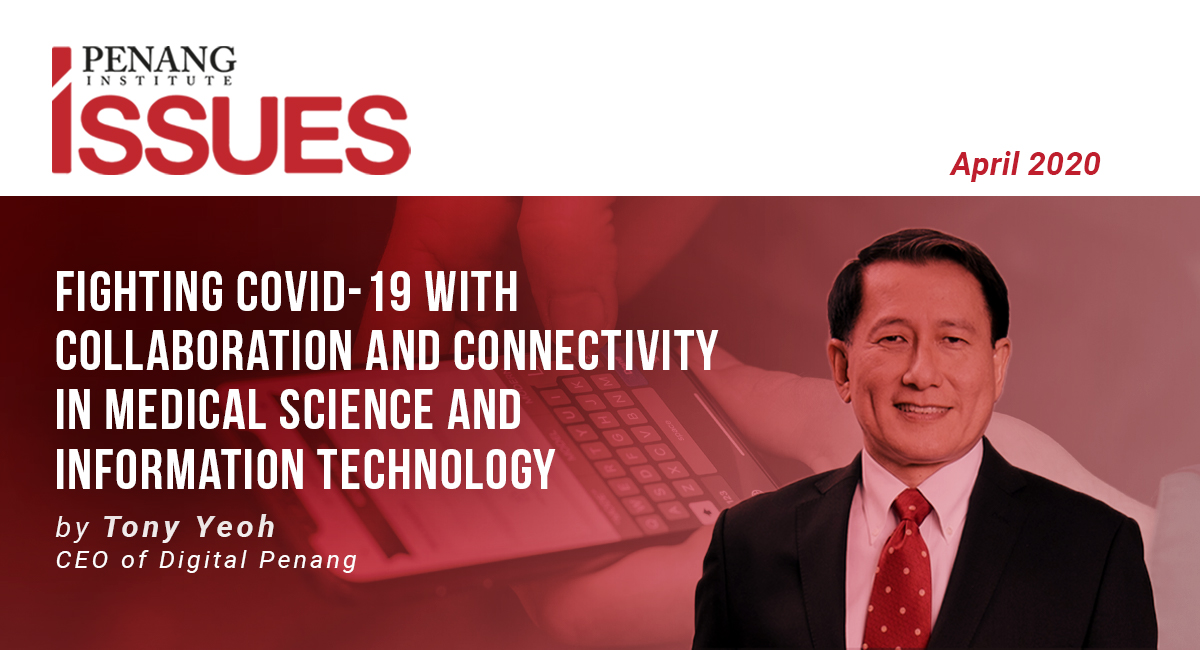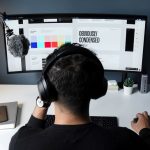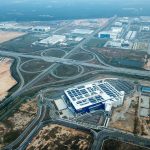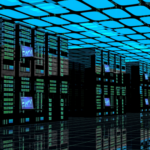Executive Summary
- The means available to mankind in 2020, in the fight against the Covid-19 pandemic appear effective, as seen in how certain technologies have been innovatively put to use to curb the spread of the highly infectious virus. The weaknesses seem more to have been in the institutional and political preparedness of governments.
- Mapping the Covid-19 genome was quickly achieved, thanks to modern technology and medical knowledge, and quickly shared among the medical research community. AI technology has also been used to identify infected patients in lieu of sufficient test kits.
- Contact-tracing apps have been quickly implemented, bottom-up in the case of Taiwan, and top-down in the case of Singapore. Digitised societies have exhibited a quicker ability to response to the crisis, be it among hacker activists or technocrats. Interestingly, Taiwan, with its strong engineering talent pool and being a society comfortable and savvy with technology positions, showed that it did not have to rely on the elite digiterati of enterprise and government.
- Innovations in the monitoring of quarantined patients have been many, based on recent information technological means and their innovative applications. Identifying clusters and predicting spikes have also been possible through decisive and effective use of information technology, as shown by South Korea.
- Social distancing is never a popular measure, wherever in the world it is enforced. However, the ability through social media and other new technological applications to socialise and stay in contact, be it among friends and family members, or for purposes of work, has made social distancing more bearable, and the spread of information more effective.
- There is therefore a strong and obvious need to develop depth in science and engineering education, and to hone agility in repurposing manufacturing to respond to shortage of resources. Evolve society to be technology savvy and create a digital culture of civic participation for harnessing ingenuity and support
Introduction
In 1918, the Spanish flu pandemic affected a quarter of the world’s population of 2 billion. About half a million people were infected and the death toll was estimated to have been about 10 percent.
Today, while the Covid-19 pandemic is still unfolding, and assuming both outbreaks are comparable, an interesting question to pose is whether advances in science and technology have helped to contain the pandemic any better than in the past. In fact, with a world that is more globally connected, and that has a population of 7 billion, prima facie, one would expect the speed, spread and severity to be higher, but so far, by fortune or feat, we may still be able to thwart its worst imaginable consequences.
So, what are some of the advances in science and technology that have better positioned us in this present fight?
Identifying the Virus
When the disease was first detected in Wuhan, scientists were able to complete the genomic sequence of the virus within days, which stands in contrast to the case of SARS, when that process took months to carry out. For those fighting on the frontline of a pandemic, time is of the essence. Once the genetic material of Covid-19 was mapped, biotechnology companies were able to reproduce synthetic copies to use for research and for developing test kits. However, this novel coronavirus proved a tricky one to detect, and the test kits had shown a high level of false positive results. Recently though, researchers have managed to improve the accuracy of the tests, and also to reduce the turnaround time for results from 3 days to a couple of hours.
During the outbreak in Wuhan, in the face of dwindling supplies of PCR test-kits and the long turnaround time for results, doctors changed the diagnostic strategy to include computer tomography (CT) scans of lungs to detect lesions. This approach dramatically increased the workload of radiologists who had to visually review up to 300 images for one patient. A deep learning artificial intelligence (AI) algorithm was then introduced to help quickly triage patients to detect Covid-19 signatures in the images such as single or multiple small patchy ground-glass opacities and thickening, and the algorithms could even differentiate against normal viral pneumonia. These AI algorithms not only improved human efficiency and accuracy but also minimised risky physical contact in the examination process.
While to date a vaccine and cure seems elusive, knowledge accumulated from previous outbreaks such as SARS and MERS, has helped shorten development time. In fact, clinical trials have already commenced for some of the vaccines. In the past, to develop a vaccine would take 10 to 15 years and costs about a billion US dollars. Today, researchers are confident that it would take a year to 18 months for a vaccine against Covid-19 to emerge.
Awareness and Contact Tracing
Amongst the initial affected countries, those that invested early efforts into contact tracing and isolation managed to keep the outbreak fairly under control and increased their chances of dodging the exponential spike in cases.
Taiwan, for example, has a bottom-up citizen approach for tapping on the wisdom of crowds, where many technology activists collaborate and develop apps for the community to share and use. When cases initially surfaced in the wake of passengers arriving on a cruise ship with a high rate of infection, people immediately began using a community-developed platform to voluntarily share information about their symptoms, and these data were then combined with smartphone apps that users could download to map their location history in order to determine if they had been exposed.
Concurrently, and in contrast, Singapore through its GovTech organisation, introduced a mobile app, TraceTogether, for residents to download which uses Bluetooth to store encrypted proximity information when a user is near other TraceTogether smartphones. When contact tracing is needed, the Ministry of Health then seeks consent for the data to be uploaded for analysis. For this to work and for the network effect to become pervasive, many smartphone users are required to download the app and turn their Bluetooth on.
The Taiwanese response has been lauded as open, democratic and engaging as it is based on civic participation by technology hackers and social activists. The strong engineering talent pool and a society comfortable and savvy with technology positions it well to respond with rapid prototyping of solutions without relying on the elite digiterati of enterprise and government as in other countries.
Border Control, Containment and Quarantine
As the Covid-19 virus spread, many countries closed borders and stopped flights only after many cases had passed through, and been imported. Initially, the screening method used was just the scanning of body temperature. It took a while before it was realised that this was not an effective way of identifying the infected; carriers of the virus could often be asymptomatic.
Taiwan has integrated its national health insurance database with its immigration and customs database and uses big data analytics to generate real-time alerts based on travel history and clinical visits. This data is then used for immigration clearance to identify infected persons for quarantine. For those who test positive and also to ensure people stay at home under quarantine, the government uses GPS location tracking of personal mobile phones to create a virtual “geofence”. By monitoring phone signals, the system alerts the police and local authorities if a person is not within the radius of the house or switches off the phone. To ensure the person does not leave the phone at home, calls are made to it twice daily. Such measures of combining human effort and technology has helped to make the quarantine effective. Expectedly, complaints of intrusion on privacy were received.
In Hong Kong, location-tracking wristbands are given to those put under quarantine. In Singapore, the government uses text messages to contact people, who must click on a link to prove they are at home. Thailand has rolled out a mobile app that anyone arriving at an airport must download to help monitor where they have been in the event that they test positive for the virus.
In China, hospitals use robots to deliver meals and medicine to patients under quarantine. The use of robots to do routine mundane tasks has been a great help, and frees health workers to focus on other high-touch tasks and also reduced the exposure risks of health workers. Some cities in China have also taken to using drones to announce movement restriction orders, and also to spray disinfectants in public areas.
Cluster and Spike Prediction
In choosing not to adopt a hard-line lockdown approach, South Korea’s success in controlling the outbreak is not only in its wide-scale testing but also in its ability to use analytics to predict the cluster source. They set up phone booths and drive-throughs to test those with symptoms or those referred by a doctor, each taking an average of 7 minutes. At time of writing, they have tested up to 300,000 people. With the data collected, they have been able to pinpoint infection sources. Disinfection teams are then sent to the area and message alerts texted to members of the public to inform them of past movements of infected patients in their area, and with details on the names of shops and restaurants visited. South Korea has leaned towards a softer approach of information dissemination and encourages residents to stay at home, wear masks, and practise social distancing. With the vast amount of data collected, they have been able to analyse and use mathematical models to understand and predict the speed and spread of the disease.
Many countries including Malaysia, use mathematical models to predict when the exponential spike of cases will occur and have taken action to partially control public movement so as to “flatten the curve”, a slowing down of the spread. One of the reasons Italy was hit so badly is probably due to the slow anticipation and preparation. By the time lockdown was in force, cases had already started to surge exponentially. The hospitals could not cope with the overwhelming number of cases, and quickly ran out of supplies and ventilators; hence forcing their doctors to make hard life-and-death choices based on the age or survival chances of patients.
Movement Restriction and Impact on Resource Allocation and Mental Health
One of the biggest dilemmas for many countries is in making the trade-off decisions on whether to lockdown territories in order to flatten the curve, or press on with control measures of tracing and testing. It is largely an economic decision balancing the cost of treating the illness against the cost of controlling and preventing the spread of the illness. There are many variations to this movement restriction and much depends on how services classified as essential are allowed to continue to operate. Whichever way such a decision is made, it causes panic buying and hoarding. Most systems in our society, from food supply to banking to healthcare, are tuned to cope with normal supply and demand, but when there is a spike, whether caused by panic or force majeure, the subsequent rush for household items will put tremendous and abnormal pressure on the system, pushing it towards collapse.
In the current crisis, many have experienced a shortage of face masks, disinfectants and the infamous toilet rolls, so the challenge lies in achieving transparent dissemination of information to calm nerves and prevent herd behaviour.
To address this issue, Taiwan implemented the Face Mask Map, a joint collaboration initiated by an entrepreneur with the government’s Digital Ministry. Learning from their 2003 SARS experience, to prevent panic buying and hoarding of facemasks, the government instituted a ration of 2 facemask per week per citizen. To ensure that there are no raids on pharmacies, the Digital Ministry released an application programming interface (API) that provides real-time location specific data to the public on mask availability. Such information transparency allows citizens to reallocate rations by trading and donating amongst themselves to prevent gouging by the black market.
In China, the government worked with eWallet providers such as WePay and AliPay to tap on the QR code. Each time a resident enters a building, the QR code is scanned, temperature recorded and coded as red, yellow or green. The city then uses surveillance cameras with facial recognition to track movement of residents. Between cities, at each toll gate, the QR code is scanned and only those that show green are allowed to proceed on their journey to another city or location. Naturally, this has been criticised as too authoritarian and as infringement on personal liberties. But in the interest of public safety, many have been willing to abide and comply.
One of the beneficiaries from this crisis is online shopping and food delivery. As many restaurants are closed for dine-ins, take-outs and home delivery have become the fashion. In China, deliveries now even practise social distancing by leaving parcels in designated enclosed bins for collection by recipients, totally avoiding any person-to-person contact at all.
A consequence of staying at home for prolonged periods of time is boredom and the deterioration of mental health. If we had experienced this lockdown during SARS in 2003, many of the technologies that we enjoy today would not have existed yet; most were only started in 2005. Staying at home without Youtube, Netflix, TikTok, Zoom, elibraries, video games, and many of the apps on the smartphone, would have made life much more miserable than it is now, when we live with movement control.
Telemedicine and Telecommuting
In Singapore, one of the challenges faced early in the crisis was doctor-hopping. In one case, a patient with flu-like symptoms was going from one clinic to as many as three other clinics on consecutive days, thereby exposing many to the virus. The government quickly communicated to the public to stop this behaviour and encouraged visits to designated hospitals or to use telehealth where doctors can remotely triage patient symptoms while they are still at home. In Singapore, more than a million people have used a popular telehealth app called MaNaDr. Physicians on MaNaDr pre-screen patients and advise them to stay home if they do not need intensive care. Patients then check in with their telehealth doctor every evening and report symptoms such as whether fever persists, shortness of breath or other complications. If the health condition deteriorates, the doctor orders an ambulance to take the patient to the hospital. Such telemedicine helps to offload pressure on critical front-line resources, and still gives the patient the comfort of being monitored and cared for.
One major source of transmission has been in crowded subways and mass rapid transit (MRT) systems. To mitigate this, many countries are encouraging people to “work from home”. The economy would thus have been in far worse shape had it not been for telecommuting. This concept, mooted over the last two decades, is now starting to gain traction and is being accepted as a workable norm. In fact, Singapore has gone so far as to threaten to stop work orders for employers who do not set up infrastructure and allow workers to telecommute where practicable. Technologies for video conferencing such as Zoom and BlueJeans have become so robust and popular that they have become a viable option.
Fighting Misinformation
In a crisis, being transparent and providing accurate up-to-date information to the public are paramount for allaying fears and mistrust. Holding press briefings on a daily basis and providing convincing data to demonstrate that the situation is under control inspires public confidence. As fast as the virus spreads, fake news also go viral on social media; hence addressing them as soon as these are detected in the respective channels, is crucial to the stamping out of misinformation and rumours that may cause fear and panic.
Lessons for Reflection
As often as technology has been blamed for some of our social ills, the positive side of the double edge has shown its value in tackling the current crisis.
For countries that have suffered the brunt of the epidemic, it is apparent that what has remained unchanged though is the inertia and slow reaction of the bureaucracy, and the lack of political will and courage to make the hard choices despite the early warning signs. This epidemic is not only a challenge to the national healthcare system of many countries but also a test on the social capital and trust between the state and its citizens and a reality check on the unity, tolerance and attitudes of people. The latter are mostly human values that technology cannot solve but that will probably be put under a stronger spotlight by social media.
Another outcome to reflect on is that countries can no longer afford to downplay the need among its people for a science and engineering education and industry, let alone neglect it. The fact that China could build a hospital in 10 days, gear up the supply of masks and ventilators and do genome sequencing illustrates how far that country has progressed in deepening its science and technology prowess.
Also, the fact that some countries have been able to tap on the wisdom of crowds with community participation instead of relying on top-down paternalistic solutions stresses the need to develop a pool of technology talent and a society with a savvy digital culture.
Lastly, the key to early response lies in looking beyond centuries-old strategies of social isolation and social distancing. While they may be the most effective ways to break the chain of viral transmission, we still need to tap more on technology connectivity to fight pandemics in the future.
Most of the technology applications and methods used in Asia have been criticised in the West as unworkable and as infringements on individual independence. Perhaps Asia has a stronger belief in interdependence and that the sacrifice of the few for the sake of the collective good reigns supreme in a crisis.
Managing Editor:Ooi Kee Beng, Editorial Team: Alexander Fernandez and Nur Fitriah (designer)
You might also like:
![Persevering towards Recovery for Penang’s Tourism Industry]()
Persevering towards Recovery for Penang’s Tourism Industry
![TVET in Malaysia: Current Situation, Challenges and Recommendations]()
TVET in Malaysia: Current Situation, Challenges and Recommendations
![[Rapporteur Notes] Penang Economic Summit 2022: The Post-Pandemic Economic Reset]()
[Rapporteur Notes] Penang Economic Summit 2022: The Post-Pandemic Economic Reset
![Can Batu Kawan Industrial Park be the Silicon Valley of the East?]()
Can Batu Kawan Industrial Park be the Silicon Valley of the East?
![Building Malaysia's Digital Future: Balancing Growth, Sustainability, and Public Perception in the D...]()
Building Malaysia's Digital Future: Balancing Growth, Sustainability, and Public Perception in the D...




![[Rapporteur Notes] Penang Economic Summit 2022: The Post-Pandemic Economic Reset](https://penanginstitute.org/wp-content/uploads/2022/12/thumbnail-1-150x150.jpg)


